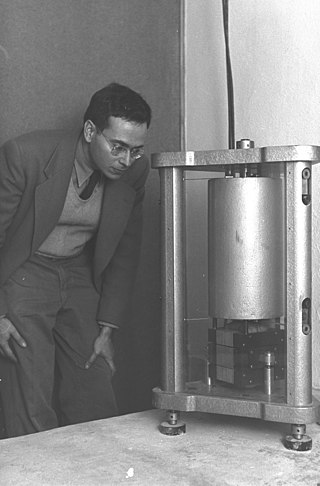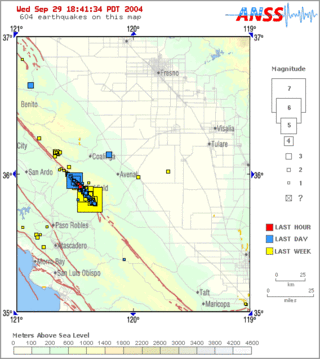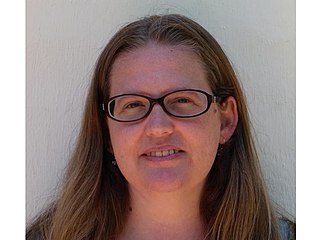Related Research Articles

Seismology is the scientific study of earthquakes and the generation and propagation of elastic waves through the Earth or other planetary bodies. It also includes studies of earthquake environmental effects such as tsunamis as well as diverse seismic sources such as volcanic, tectonic, glacial, fluvial, oceanic microseism, atmospheric, and artificial processes such as explosions and human activities. A related field that uses geology to infer information regarding past earthquakes is paleoseismology. A recording of Earth motion as a function of time, created by a seismograph is called a seismogram. A seismologist is a scientist works in basic or applied seismology.

Frank Press was an American geophysicist. He was an advisor to four U.S. presidents, and later served two consecutive terms as president of the U.S. National Academy of Sciences (1981–1993). He was the author of 160 scientific papers and co-author of the textbooks Earth and Understanding Earth.

Parkfield earthquake is a name given to various large earthquakes that occurred in the vicinity of the town of Parkfield, California, United States. The San Andreas fault runs through this town, and six successive magnitude 6 earthquakes occurred on the fault at unusually regular intervals, between 12 and 32 years apart, between 1857 and 1966. The latest major earthquake in the region struck on September 28, 2004.
The 1857 Fort Tejon earthquake occurred at about 8:20 a.m. on January 9 in central and Southern California. One of the largest recorded earthquakes in the United States, with an estimated moment magnitude of 7.9, it ruptured the southern part of the San Andreas Fault for a length of about 225 miles, between Parkfield and Wrightwood.
The 1999 Hector Mine earthquake occurred in Southern California, United States, on October 16 at 02:46:50 PDT. Its moment magnitude was 7.1 and the earthquake was preceded by 12 foreshocks, the largest of which had a magnitude of 3.8. The event is thought to have been triggered by the 1992 Landers earthquake which occurred seven years earlier. It also deformed nearby faults vertically and horizontally. The earthquake's hypocenter was at a depth of 20 kilometers and its epicenter at 34.603° N 116.265° W.

The Newport–Inglewood Fault is a right-lateral strike-slip fault in Southern California. The fault extends for 47 mi (76 km) from Culver City southeast through Inglewood and other coastal communities to Newport Beach at which point the fault extends east-southeast into the Pacific Ocean. The fault comes back on shore in the La Jolla area of San Diego and continues southward to downtown San Diego. In San Diego it is known as the Rose Canyon Fault. The fault can be inferred on the Earth's surface as passing along and through a line of hills extending from Signal Hill to Culver City. The fault has a slip rate of approximately 0.6 mm (0.024 in)/year and is predicted to be capable of a 6.0–7.4 magnitude earthquake on the moment magnitude scale. A 2017 study concluded that, together, the Newport–Inglewood Fault and Rose Canyon Fault could produce an earthquake of 7.3 or 7.4 magnitude.
Kate Hutton, nicknamed the Earthquake Lady, Dr. Kate, or Earthquake Kate, is a former staff seismologist at the California Institute of Technology in Pasadena, California, where she monitored Southern California's earthquake activity for 37 years.

Andrew Cowper Lawson was a Scots-born Canadian geologist who became professor of geology at the University of California, Berkeley. He was the editor and co-author of the 1908 report on the 1906 San Francisco earthquake which became known as the "Lawson Report". He was also the first person to identify and name the San Andreas Fault in 1895, and after the 1906 quake, the first to delineate the entire length of the San Andreas Fault which previously had been noted only in the San Francisco Bay Area. He also named the Franciscan Complex after the Franciscan Order of the Catholic church whose missions used conscripted Native American labor to mine limestone in these areas.
Clarence Roderic Allen was an American geologist who studied seismology.

Lucile M. Jones is an American seismologist and public voice for earthquake science and earthquake safety in California. One of the foremost and trusted public authorities on earthquakes, Jones is viewed by many in Southern California as "the Beyoncé of earthquakes" who is frequently called upon to provide information on recent earthquakes.

The San Jacinto Fault Zone (SJFZ) is a major strike-slip fault zone that runs through San Bernardino, Riverside, San Diego, and Imperial Counties in Southern California. The SJFZ is a component of the larger San Andreas transform system and is considered to be the most seismically active fault zone in the area. Together they relieve the majority of the stress between the Pacific and North American tectonic plates.
George W. Housner was a professor of earthquake engineering at the California Institute of Technology and National Medal of Science laureate.

Leon Theodore "Lee" Silver was an American geologist who was professor of geology at the California Institute of Technology (Caltech). He was an instructor to the Apollo 13, 15, 16, and 17 astronaut crews. Working with the National Aeronautics and Space Administration (NASA), he taught astronauts how to perform field geology, essentially creating lunar field geology as a new discipline. His training is credited with a significant improvement in the J-Mission Apollo flights' scientific returns. After the Apollo program, he became a member of the United States National Academy of Sciences in 1974. He retired in 1996 as the W. M. Keck Foundation Professor for Resource Geology, emeritus, at Caltech.
The 1940 El Centro earthquake occurred at 21:35 Pacific Standard Time on May 18 in the Imperial Valley in southeastern Southern California near the international border of the United States and Mexico. It had a moment magnitude of 6.9 and a maximum perceived intensity of X (Extreme) on the Mercalli intensity scale. It was the first major earthquake to be recorded by a strong-motion seismograph located next to a fault rupture. The earthquake was characterized as a typical moderate-sized destructive event with a complex energy release signature. It was the strongest recorded earthquake in the Imperial Valley, causing widespread damage to irrigation systems and killing nine people.
The 1948 Desert Hot Springs earthquake occurred on December 4 at 3:43 p.m. Pacific Standard Time with a moment magnitude of 6.4 and a maximum Mercalli intensity of VII. The shock was felt from the central coast of California in the north, and to Baja California in the south, and came at a time when earthquake research in southern California resumed following the Second World War. It was one of two events in the 20th century that have occurred near a complex region of the southern San Andreas Fault system where it traverses the San Gorgonio Pass and the northern Coachella Valley. Damage was not severe, but some serious injuries occurred, and aftershocks continued until 1957.
Harry Oscar Wood (1879–1958) was an American seismologist who made several significant contributions in the field of seismology in the early twentieth-century. Following the 1906 earthquake in San Francisco, California, Wood expanded his background of geology and mineralogy and his career took a change of direction into the field of seismology. In the 1920s he co-developed the torsion seismometer, a device tuned to detect short-period seismic waves that are associated with local earthquakes. In 1931 Wood, along with another seismologist, redeveloped and updated the Mercalli intensity scale, a seismic intensity scale that is still in use as a primary means of rating an earthquake's effects.
James H. Dieterich is an American geophysics professor emeritus at University of California, Riverside (UCR).

Jeanne L. Hardebeck is an American research geophysicist studying earthquakes and seismology who has worked at the United States Geological Survey (USGS) since 2004. Hardebeck studies the state of stress and the strength of faults.
Richard Hugh Sibson is a New Zealand structural geologist and emeritus professor at the University of Otago, who has received numerous honors and awards for his work in the field of earthquake research. He has caused a 'fundamental shift' in the interpretation of the relationship between earthquakes and fault zone geology and on the origin of fault-hosted mineral deposits.

Danny Hilman Natawidjaja is an Indonesian geologist specializing in earthquake geology and geotectonics at the Indonesian Institute of Sciences (LIPI) Research Center for Geotechnology.
References
- ↑ "Kerry Sieh :: Division of Geology and Planetary Sciences at Caltech". Gps.caltech.edu. Archived from the original on 2013-03-25. Retrieved 2013-11-02.
- ↑ "88 for 1988: Meet Southern California's Rising Stars". Los Angeles Times. 10 January 1988. Archived from the original on 19 October 2019.
- 1 2 BSSA (January 6, 2014). "Pioneering geologist Kerry Sieh awarded top honor in seismology" (PDF) (Press release). Seismological Society of America.
- ↑ "The AXA Research Fund Launches its First Chair in Asia | AXA Research Fund". Axa-research.org. 2012-02-28. Archived from the original on 2013-11-03. Retrieved 2013-11-02.
- ↑ "NOGLSTP to Honor Sieh, Ventzek, Denton, and Parga at 2006 Awards Ceremony in February". NOGLSTP. Retrieved 2019-02-19.